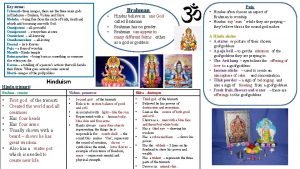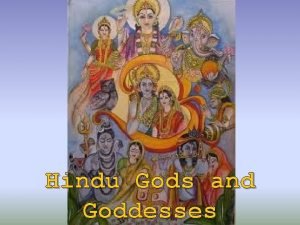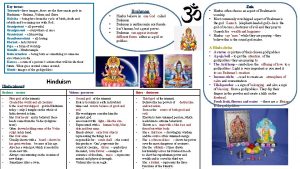Key terms Trimurti three images these are three


- Slides: 2

Key terms: Trimurti – three images, these are three main gods in Hinduism – Brahma, Vishnu and Shiva Moksha – being free from the cycle of birth, death and rebirth and becoming one with God. Omnipotent – all-powerful Omnipresent – everywhere at once Omniscient – all-knowing Omnibenevolent – all-loving Eternal – lasts forever Puja – a form of worship Mandir – Hindu temple Reincarnation – being born as something or someone else when you die. Karma – a totalling of a person’s actions that will decide their future. What goes around comes around. Murti – images of the god/goddess Hindu trimurti Brahman • • • Hindus believe in one God called Brahman has no gender. Brahman can appear in many different forms either as a god or goddess. Hinduism Brahma - creator Vishnu - preserver Shiva - destroyer • • • First god of the trimurti Created the world and all creatures Has four heads Has four arms Usually shown with a beard – shows he has great wisdom. Also has a water pot which is needed to create new life. • • • Second god of the trimurti Role is to restore balance of good and evil Associated with light – like the sun. Represented with a human body, blue skin and four arms. Hands always carry four objects representing the things he is responsible for: conch shell – the sound this makes ‘Om’, represents the sound of creation, discus – symbolises the mind, lotus flower – example of existence of freedom, mace – represents mental and physical strength. • • Third god of the trimurti Believed he has powers of destruction and recreation. Seen as the source of both good and evil. Shown as a man with a blue face and throat but white body. Has a third eye – showing his wisdom Has a cobra necklace – shows his power Has the vibhuti – 3 lines on his forehead to show his power and wealth. Has a trident – represents the three parts of the trimurti Dresses in animal skin. Puja • Hindus often choose an aspect of Brahman to worship • Hindus say ‘aum ’ while they are praying – they believe this is the sound god makes. A Hindu shrine • A statue or picture of their chosen god/goddess • A puja bell – to get the attention of the god/goddess they are praying to. • The Arti lamp – symbolises the offering of love to a god/goddess. • Incense sticks – used to create an atmosphere of calm and concentration. • Tilak powder – a sign of belonging and also a sign of blessing from a god/goddess. • Fresh fruit, flowers and water – these are offerings to the god/goddess.

Mandir • Mandir is the Hindu place of worship What is in a mandir? • Gopuram – A gateway or tower that marks the entrance to the grounds. The Guardian – between the gopuram and mandir there is a statue of an animal which spiritually protects the shrines inside. • Ardhamandapa – porch or entrance. • Bell – ring a bell to announce their arrival to the gods/goddesses. • Mandapa – main prayer hall. • Garbha Griha – main shrine. Means ‘womb house’ as it symbolises the womb or heart that gives life to the whole temple. • Shikara – spire on the roof that symbolise the journey of the soul up to God. • Murti – image of a god/goddess. • Puja tray – a tray with various objects needed for worship. • Prasad – food offered to the murtis. • Symbols - Mandirs are decorated with many different symbols including: the Om /Aum - represents the one unseen God; the lotus flower which symbolises purity and beauty; and the swastika , which represents the sun and God’s blessings. • Haveli – originally a building with rooms built around a courtyard. • Brahmin – Hindu priest. • Reincarnation People believe after death, people are born again. This is based on their actions in life. The chain of rebirth • The lowest in the chain of rebirth is plant life, followed by insect life, animal life, human life and then finally life as a Brahmin (Hindu priest). • When someone comes back as a Brahmin, they achieve ‘moksha’ when they die. Hinduism Diwali • • The festival of light Celebrated to remember Rama and Sita’s return from banishment and after defeating the evil demon king Ravana. Lakshmi • Also honours Lakshmi , the goddess of wealth. • S ome Hindus will say prayers to the goddess for a successful year. • Lamps are lit to help Lakshmi find her way into people's homes. How it is celebrated • spring-cleaning the home • wearing new clothes • exchanging gifts (often sweets and dried fruits) and preparing festive meals • worshipping at the temple • Making patterns • lights and huge firework displays often celebrate Diwali



